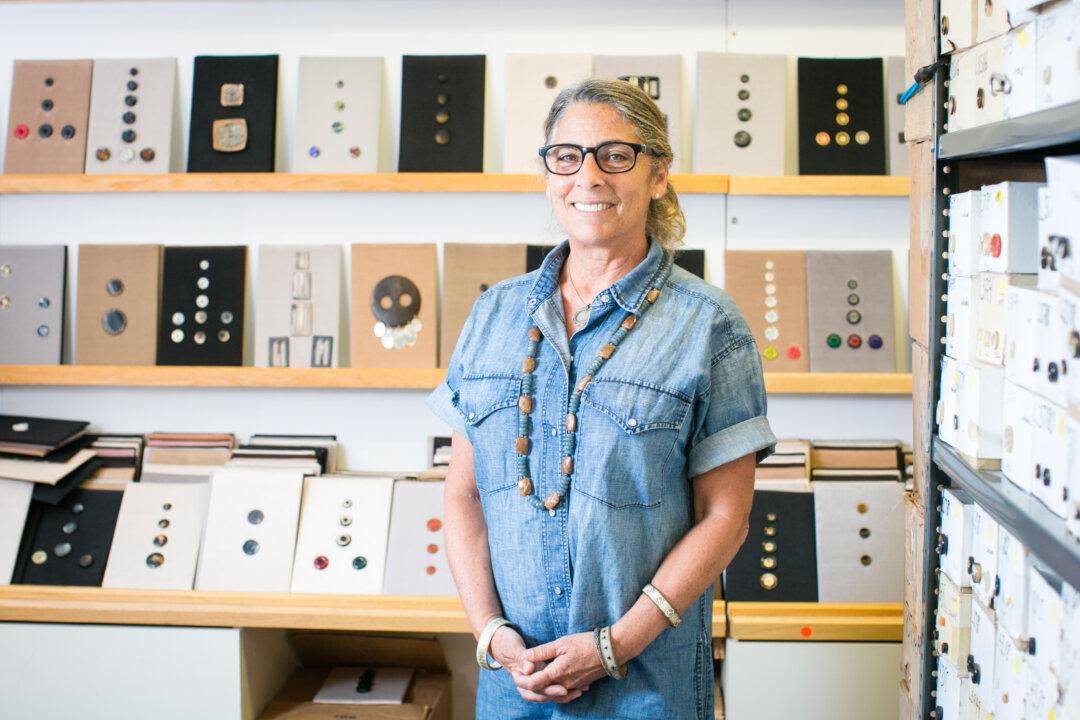NEW YORK—It all started with reflections in a watery pool, the first mirror in which as woman, or man, we beheld our own countenance. Then came a box, filled with one or more beauty accoutrements. Then there was a table covered with cloth, with the box on top. And finally, the dressing table with the box on top.
Thus was born the dressing table as we know it—or rather as we knew it, since not only is it in decline but has been made virtually obsolete by the bathroom.
The history of the dressing table spans millennia and is studded with fascinating insights into our daily rituals, our views on beauty, and even our values.
“Metropolitan Vanities: The History of the Dressing Table” at The Metropolitan Museum of Art explores the evolution of the modern dressing table. The exhibition provides an overview of the origins and development of the dressing table from antiquity to the present day with some 50 related objects, paintings, and drawings selected mainly from the museum’s own collection.
Hair and make-up, it seems, was a ubiquitous daily ritual in many cultures, and not a privilege that was only afforded by the upper classes of society.
Kohl For All
Exhibition curator Jane Adlin points out that, in Egypt, for example, it was culturally acceptable for all classes to wear make-up, and kohl was available and affordable in Egypt. Common people may not have had luxurious carved boxes but they had cosmetic boxes.
The blue faience kohl tube holder in the form of a papyrus column (Egyptian, New Kingdom, Dynasty 18, ca. 1390–1352 B.C.) featured among the Egyptian accoutrements is wonderfully intricate.
“Women have always wanted to make themselves beautiful, either for themselves or for their husbands or consorts, and that’s what’s so interesting about the dressing table. We always think of it as kind of upper-class, but it’s not really the case,” Adlin said.
The exhibition features mainly accoutrements and dressing tables that are clearly on the opulent side. There are ornate boxes that have been crafted to hold a variety of beautifying paraphernalia, including jars for cosmetics, flasks for rare perfumes and exotics oils, implements for applying makeup, and mirrors.
Expect to zigzag through the centuries in artifacts, all for the purpose of enriching the morning toilette, and wonder at the sophistication of their craftsmen.
The Dressing Table’s Glory Days
One of the most imposing dressing tables in the display is designed by Armand-Albert Rateau (French, 1882–1938) dating from circa 1925. The Art Deco bronze and basalt piece inspired by ancient Pompeii is probably the most well know pieces of furniture at the Met, according to Adlin. Its clean lines fitted well with the emerging modern aesthetic at the time, yet upon closer inspection, the details of symmetrical birds and feathers are full of drama and make-believe.
It would have been given prime place in a bedroom, or dressing room, where the lady of the house would methodically apply make-up in her private boudoir, away from prying eyes.
Although not so in the case of Madame de Pompadour, chief mistress of Louis XV, who lived in an age of opulence and ostentation.
According to Adlin, by the mid-18th century, the dressing table had become an important piece of furniture, just as important as the living room or the salon furniture, and much sought after.
Images of Madame de Pompadour or Marie Antoinette show that “their tables are laden with jewelry and incredibly ornate boxes and mirrors, and they’re all dressed in finery, so they’re all ready to show themselves off,” said Adlin. She explains further that they may have dabbed on a little make-up here and there, for effect, “but the point is that you were allowed into their inner sanctum. It was a way of holding court.”
Jean-François Oeben’s mechanical table is the most lavish piece in the exhibition. It was most likely intended for Madame de Pompadour’s château overlooking the Seine river. Depicted among the abundant bouquet of flowers in precious wood marquetry, there are the symbols of the arts to which Madame de Pompadour was partial. At this point, the dressing table had well and truly reached the apogee of its popularity and became a way of showing one’s status.
Another Kind of Aesthetic
Across the oceans, in Japan, there was introversion, order, and silence. Despite the “Mother and Child” print (ca. 1793) by Kitagawa Utamaro, (1754–1806) showing a disheveled mother at her morning toilette while breast-feeding her infant, the daily beauty ritual was most likely usually performed with the greatest economy of gestures.
The wife of a landlord, or well-to do single young lady, would have had attendants to comb their hair in preparation for an elaborate hairstyle, of which there were hundreds. It meant prolonged periods of time spent at the dressing table.
The Utamaro print and the 19th-century cosmetic lacquer stand that is also part of the exhibition chronicle two extremes of the same Japanese ritual.
Fascinating objects in the exhibition also include a range of combs, some worn by men as decorative accessories.
The Man’s Comb from the Solomon Islands, (late 19th–early 20th century) made from wood, shell, paint, and fiber shows just how thoughtful men in the south Pacific were in fashioning their own appearance. It was worn at special occasions, and it even had a fiber loop at the top where freshly picked, brightly colored leaves would be held.
Over to our shores, the dressing table for both men and women was more understated and even mobile. The exhibition piece attributed to Duncan Phyfe (American, 1770–1854) is called simply Worktable (1805–15), and is on wheels. Made of expensive woods, it served as writing desk, sewing table, and dressing table. Apparently this Grecian-style worktable was popular with New York ladies.
Out With the Dressing Table, In With the Bathroom
The exhibition comes full circle with the contemporary work of Korean designer Byung Hoon Choi called “Beyond the Image 013-01”, 2013.
It is one of the few examples of a contemporary free-standing dressing table and was acquired by the Met for the exhibition. Adlin said that finding the Korean designer was a thrill and came as a total surprise: “It was such a fitting ending because his mirror is polished stainless steel. So that brings the whole story to the present. From polished stones in ancient times, to today’s dressing table.”
Adlin said that it gave her some hope that we might still see dressing tables around in a hundred or a thousand years’ time.
Our modern lifestyles are uniquely busy when compared with the lifestyles of our predecessors or even that of our parents. The concept of multi-tasking, by its very existence, suggests our need to fit more into our days.
The dressing table has been superseded by the bathroom. The morning routine is just that—reduced to a rushed scramble of putting on make-up while standing, drying one’s hair, and possibly trying to ward off family members who await their turn.
In the future perhaps even the bathroom will stand alongside the dressing table in a museum exhibit as one of history’s quaint advents.
“Metropolitan Vanities: The History of the Dressing Table” at The Metropolitan Museum of Art is on view until April 13, 2014.





